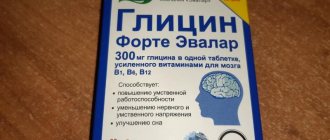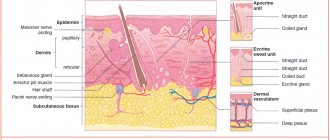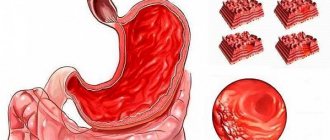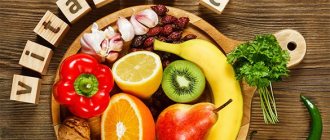What is glycine and what is its role in the body? Glycine is a non-essential amino acid that is involved in many vital processes and also helps to survive emergency situations. The key role of glycine is its direct participation in the process of energy formation in cells, protecting them from premature death and ensuring proper functioning. This is a unique substance with almost universal properties, which our body can produce on its own, but at the same time often experiences an increased need for it.
Composition/description
Registration number: LSR-001431/07
Trade name: Glycine
International nonproprietary name:
glycine.
Dosage form:
sublingual tablets.
Composition per tablet:
microencapsulated glycine (in terms of the active ingredient glycine - 100 mg), excipients: methylcellulose - 1 mg, magnesium stearate - 1 mg.
Description:
round flat-cylindrical tablets of white or almost white color with marbling elements with a chamfer and a score.
Biological role of glycine
Glycine is an inhibitory transmitter that, when overexcited, protects the nervous system from overload, providing protective inhibition. It has a calming property, but does not depress, but stimulates metabolic processes in neurons, as it stimulates cellular respiration. Therefore, after taking glycine as an anti-stress drug, there is no drowsiness or decreased cognitive function.
Glycine is an integral part of the mitochondrial respiratory chain, the Krebs cycle. During cellular respiration, glycine molecules are able to enhance the activity of oxidative reactions, increasing the efficiency of resource use to produce ATP. In case of intoxication, stress, or dysfunction of external respiration and blood circulation, the function of cellular respiration is disrupted, the cell suffers from a lack of ATP, which can lead to its death if problems with cell respiration are not resolved. Glycine helps solve the problem by restoring the activity of the Krebs cycle.
Pharmacological properties
Pharmacotherapeutic group:
metabolic agent.
ATX code:
N06BX.
Pharmacodynamics: Glycine is an amino acid and one of the main inhibitory neurotransmitters in the brain. Glycine normalizes and activates protective inhibition processes in the central nervous system, reduces psycho-emotional stress, and increases mental performance.
Glycine has glycine- and GABA-ergic, alpha1-adrenergic blocking effects, regulates the activity of glutamate (NMDA) receptors.
The drug has the following properties:
- – reduces psycho-emotional stress, aggressiveness, conflict, increases social adaptation;
- – improves mood;
- – makes it easier to fall asleep and normalizes sleep;
- – increases mental performance;
- – reduces vegetative-vascular disorders (including during menopause);
- – reduces the severity of brain disorders in ischemic stroke and traumatic brain injury;
- – reduces the toxic effect of alcohol and other drugs that depress the function of the central nervous system.
Pharmacokinetics:
easily penetrates into most biological fluids and tissues of the body, incl. into the brain; metabolized to water and carbon dioxide; accumulation in the body does not occur.
Why is it necessary to take glycine in the form of a drug?
During normal functioning of the body, glycine is produced in sufficient quantities. However, when there is an acute need for this amino acid, for example during stress or excessive physical activity, its internal reserves are quickly used up, and it is not so easy to compensate for the gradually arising deficiency. Indeed, under unfavorable conditions, other tasks appear in the body. Therefore, there is a risk of developing glycine deficiency. In this regard, there is a need for additional supply of this amino acid from the outside. Moreover, it is impossible to compensate for the deficiency only with products containing it. To do this, you need to start taking glycine in the form of a medicine. And it should be done correctly.
The most advanced form of the drug Glycine is tablets for buccal and sublingual administration. The uniqueness of this form is that the drug was created using microencapsulation technology. That is, each glycine molecule is enclosed in a separate capsule, due to which it is not destroyed, but at the same time maintains high bioavailability. The absorption process begins in the oral cavity, where the substance easily penetrates through the mucous membrane into the bloodstream and quickly spreads throughout the body. A person who takes Glycine regularly does not develop an addiction to the drug. In addition, such an intake of amino acids from the outside is an impetus for its production by the body’s own forces.
Indications for use
Indications for use:
- – reduced mental performance;
- – stressful situations - psycho-emotional stress (during exams, in conflict situations, etc.);
- – deviant (deviating from the norm) forms of behavior of children and adolescents;
- – various functional and organic diseases of the nervous system, accompanied by increased excitability, emotional instability, decreased mental performance, memory and sleep disturbances: neuroses, neurosis-like conditions and vegetative-vascular dystonia, stress nervous disorders, consequences of neuroinfections and traumatic brain injury, perinatal and others forms of encephalopathies (including those of alcoholic origin);
- - ischemic stroke.
Contraindications: hypersensitivity to glycine or other components of the drug.
Precautions for use: does not require special precautions.
Use during pregnancy and breastfeeding: Glycine is not recommended for use during pregnancy and breastfeeding due to the lack of sufficient data.
Reception features
What factors determine how much Glycine you can take per day?
- Age
. The drug can be given even to infants and taken in old age, so the dosage changes taking this factor into account. - What is the drug used for
? How much Glycine you need per day depends on the reasons for use. For example, to improve sleep, half or one tablet is enough, but for a stroke, 10 tablets with a small amount of water are used at once. - Individual appointment
. Consultation with your doctor will help you adjust your dosage regimen and the number of tablets for daily use to achieve maximum effect.
Directions for use and doses
Glycine is used sublingually or buccally (in tablets or in powder form after crushing the tablets): adults, adolescents and children over three years old - 1 tablet (100 mg), children under three years old - 0.5 tablets (50 mg).
Glycine is prescribed to practically healthy children, adolescents and adults for psycho-emotional stress, stress nervous disorders, decreased memory, attention, mental performance, mental retardation, and deviant forms of behavior: 2-3 times a day for 14-30 days.
For functional and organic lesions of the nervous system, accompanied by increased excitability, emotional lability and sleep disturbance:
- – children under three years of age: 2-3 times a day for 7-14 days, then 1 time a day for 7-10 days, daily dose - 100-150 mg, course dose - 2000-2600 mg;
- – children over three years old, adolescents and adults: 2-3 times a day for 7-14 days, daily dose - 200-300 mg, course dose - 2800-4200 mg;
On the recommendation of a doctor, the course of treatment can be increased to 30 days; if necessary, the course is repeated after 30 days.
For sleep disorders: 20 minutes before bedtime or immediately before bedtime, 0.5-1 tablet (depending on age).
For ischemic cerebral stroke: during the first 3-6 hours from the onset of stroke, 1000 mg is prescribed sublingually or buccally with one teaspoon of water, then for 1-5 days 1000 mg per day, then over the next 30 days 1-2 tablets 3 times a day.
In narcology, glycine is used as a means of increasing mental performance and reducing psycho-emotional stress during the period of remission in cases of encephalopathy, organic lesions of the central and peripheral nervous system: 1 tablet 2-3 times a day for 14-30 days. If necessary, courses are repeated 4-6 times a year.
Transbuccally - how is that?
The characteristics of the glycine molecule determine the easiest way for it to penetrate into the blood - through the mucous membrane of the mouth.
In the instructions for use, you may find the words “sublingual” or “buccal”. What “sublingual” means can be understood simply by the sound of the word - the tablet must be placed under the tongue and kept there until completely dissolved, without dissolving.
Buccal administration is the placement of a tablet or powder behind the cheek, between the cheek and gum, usually in the area of the angle of the lower jaw. Buccal administration is especially convenient for young children, children with developmental delays, neurological patients, during and after a stroke, when keeping the medicine under the tongue is problematic.
Food sources
The main sources of glycine are foods rich in protein.
A typical diet contains about 2 grams of glycine daily. It is also worth remembering that glycine is a non-essential amino acid. This means that it is regularly produced in the liver from other amino acids. Therefore, there is no urgent need to monitor the exact amount of glycine in the diet.
Animal sources: fish, dairy products, meat, cheese and others.
Plant sources: beans, soybeans, spinach, pumpkin, cabbage, cauliflower, burdock root, cucumbers, kiwi, bananas.
Other sources: aspic, marmalade, soy, chickpeas, pumpkin and sesame seeds, nuts (walnuts, peanuts, pistachios, pine), basil, fennel, ginger.
You can provide yourself with higher doses of glycine by consuming skin and bones (for example, preparing broths, jellied poultry meat with skin) or special nutritional supplements. It is important to remember that only natural ingredients are used to create glycine.
But it would be wrong to talk about food sources of glycine without remembering the factors that influence more complete absorption of the substance.
The first recommendation is nothing new - standard, but, in fact, very important advice: maintain a healthy lifestyle and eat a balanced menu.
Secondly, water is necessary for normal absorption of glycine. Proper drinking regimen (at least one and a half liters of fluid per day) will help the body extract more benefits from food.
And the third tip: an active lifestyle and regular walks in the fresh air.
What foods contain glycine?
Considering that glycine is a very common amino acid found in many proteins (both plant and animal), especially collagen (up to 35% of its composition), glycine can be obtained from many foods. The greatest amount is found in soy protein (3.6-2.7%), spirulina (3.1%), chicken egg white (2.8%), octopus meat (1.9%), pumpkin seeds (1 .8%), parsley (1.8%), as well as meat, animal skin and offal (chicken, rabbit) in beef and veal (1.6%) – i.e. A lot of glycine is found in those foods that are rich in protein in general and collagen in particular.
For those who do not have the opportunity to include a lot of animal products in their diet, there are glycine supplements that allow you to benefit from its use without changing your diet.
Drugs
Glycine is available in different dosages and volumes. Therefore, the drug can be chosen for one or several courses.
Table - Glycine Supplements
| Name | Dosage, mg | Packaging volume, pcs. | Cost, rub. |
| Glycine-Bio, Pharmaplant | 100 | 50 | from 53 |
| Glycine, LLC "Biotics" | 100 | 100 | from 73 |
| Glycine Extra | 600 | 20 | from 57 |
| Glycine, LLC "Biotics" | 100 | 50 | from 37 |
| Glycine Forte, CJSC "Canonpharma Production" | 250 | 30 | from 53 |
Glycine as a participant in other vital reactions
What is DNA? Right! Chemical substrate of heredity. Everyone knows this. But not everyone knows that each of the DNA chains consists of “building blocks” called nucleotides. Each nucleotide includes, among other things, a nitrogenous base. There are two types of nitrogenous bases in DNA: purine (adenine and guanine) and pyrimidine (thymine and cytosine). Glycine takes part in the synthesis of nucleotides with purine bases (Fig. 6).
Figure 6. DNA and purine nitrogen base diagram. a - Model of the famous “double helix”, in which the “bricks” (nucleotides) that form each of the two chains are clearly visible. b - Scheme of a purine nitrogenous base that combines with pentose in the nucleotide; part of this construct is formed by glycine.
Wikipedia
Figure 7. One of the precursors of creatine is glycine.
During the de novo synthesis of purine nucleotides, the nitrogenous base “sits” on a ready-made bond with pentose and is gradually increased. At one of the initial stages, glycine comes into play, thanks to which the structure includes two carbon atoms and one nitrogen atom.
The variety of combinations of nitrogenous bases in the DNA molecule is the basis of biological diversity on the planet.
In addition, glycine is involved in the synthesis of creatine (Fig. 7), an energy accumulator substance in muscles and nerve cells, that is, in those places of the body where it is necessary to maintain a high level of energy.
Possible consequences of increasing dosage
There are no known cases of glycine overdose. But they are possible. If you take too many tablets, adverse reactions will occur:
- allergy;
- feeling tired, lethargic, apathy;
- drowsiness;
- state of psychosis;
- headache;
- irritability, aggression.
If the medication is intolerant, schizoid disorders, epileptic seizures, and convulsions may develop. If an adult patient suffers from hypotension, his blood pressure will drop and a headache will appear.
Interaction with other substances
You must be extremely careful when taking glycine and clozapine (a drug for the treatment of schizophrenia) at the same time, since this drug stops working against the background of the amino acid. The combination of glycine and cysteine enhances the synthesis of glutathione and increases insulin sensitivity. It is important to know that aminoacetic acid enhances the absorption of aspirin, and in combination with calcium or iron improves their absorption. But for glycine itself, the presence of B-group vitamins in the body, which contribute to the processes of amino acid synthesis, is important.
Best materials of the month
- Coronaviruses: SARS-CoV-2 (COVID-19)
- Antibiotics for the prevention and treatment of COVID-19: how effective are they?
- The most common "office" diseases
- Does vodka kill coronavirus?
- How to stay alive on our roads?









